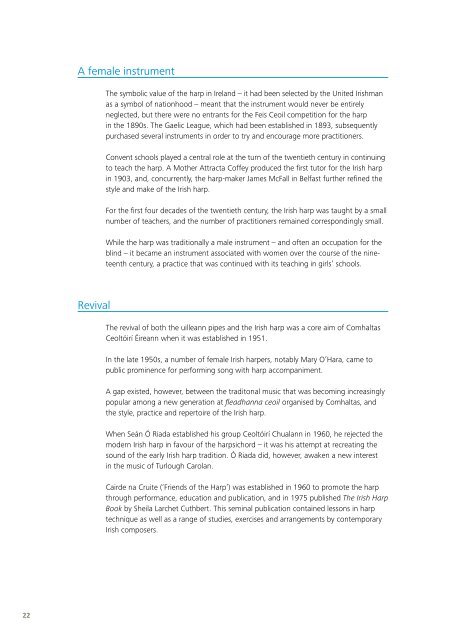You also want an ePaper? Increase the reach of your titles
YUMPU automatically turns print PDFs into web optimized ePapers that Google loves.
A female <strong>in</strong>strument<br />
The symbolic value of <strong>the</strong> harp <strong>in</strong> <strong>Ireland</strong> – it had been selected by <strong>the</strong> United Irishman<br />
as a symbol of nati<strong>on</strong>hood – meant that <strong>the</strong> <strong>in</strong>strument would never be entirely<br />
neglected, but <strong>the</strong>re were no entrants for <strong>the</strong> Feis Ceoil competiti<strong>on</strong> for <strong>the</strong> harp<br />
<strong>in</strong> <strong>the</strong> 1890s. The Gaelic League, which had been established <strong>in</strong> 1893, subsequently<br />
purchased several <strong>in</strong>struments <strong>in</strong> order to try and encourage more practiti<strong>on</strong>ers.<br />
C<strong>on</strong>vent schools played a central role at <strong>the</strong> turn of <strong>the</strong> twentieth century <strong>in</strong> c<strong>on</strong>t<strong>in</strong>u<strong>in</strong>g<br />
to teach <strong>the</strong> harp. A Mo<strong>the</strong>r Attracta Coffey produced <strong>the</strong> first tutor for <strong>the</strong> Irish harp<br />
<strong>in</strong> 1903, and, c<strong>on</strong>currently, <strong>the</strong> harp-maker James McFall <strong>in</strong> Belfast fur<strong>the</strong>r ref<strong>in</strong>ed <strong>the</strong><br />
style and make of <strong>the</strong> Irish harp.<br />
For <strong>the</strong> first four decades of <strong>the</strong> twentieth century, <strong>the</strong> Irish harp was taught by a small<br />
number of teachers, and <strong>the</strong> number of practiti<strong>on</strong>ers rema<strong>in</strong>ed corresp<strong>on</strong>d<strong>in</strong>gly small.<br />
While <strong>the</strong> harp was traditi<strong>on</strong>ally a male <strong>in</strong>strument – and often an occupati<strong>on</strong> for <strong>the</strong><br />
bl<strong>in</strong>d – it became an <strong>in</strong>strument associated with women over <strong>the</strong> course of <strong>the</strong> n<strong>in</strong>eteenth<br />
century, a practice that was c<strong>on</strong>t<strong>in</strong>ued with its teach<strong>in</strong>g <strong>in</strong> girls’ schools.<br />
Revival<br />
The revival of both <strong>the</strong> uilleann pipes and <strong>the</strong> Irish harp was a core aim of Comhaltas<br />
Ceoltóirí Éireann when it was established <strong>in</strong> 1951.<br />
In <strong>the</strong> late 1950s, a number of female Irish harpers, notably Mary O’Hara, came to<br />
public prom<strong>in</strong>ence for perform<strong>in</strong>g s<strong>on</strong>g with harp accompaniment.<br />
A gap existed, however, between <strong>the</strong> tradit<strong>on</strong>al music that was becom<strong>in</strong>g <strong>in</strong>creas<strong>in</strong>gly<br />
popular am<strong>on</strong>g a new generati<strong>on</strong> at fleadhanna ceoil organised by Comhaltas, and<br />
<strong>the</strong> style, practice and repertoire of <strong>the</strong> Irish harp.<br />
When Seán Ó Riada established his group Ceoltóirí Chualann <strong>in</strong> 1960, he rejected <strong>the</strong><br />
modern Irish harp <strong>in</strong> favour of <strong>the</strong> harpsichord – it was his attempt at recreat<strong>in</strong>g <strong>the</strong><br />
sound of <strong>the</strong> early Irish harp traditi<strong>on</strong>. Ó Riada did, however, awaken a new <strong>in</strong>terest<br />
<strong>in</strong> <strong>the</strong> music of Turlough Carolan.<br />
Cairde na Cruite (‘Friends of <strong>the</strong> Harp’) was established <strong>in</strong> 1960 to promote <strong>the</strong> harp<br />
through performance, educati<strong>on</strong> and publicati<strong>on</strong>, and <strong>in</strong> 1975 published The Irish Harp<br />
Book by Sheila Larchet Cuthbert. This sem<strong>in</strong>al publicati<strong>on</strong> c<strong>on</strong>ta<strong>in</strong>ed less<strong>on</strong>s <strong>in</strong> harp<br />
technique as well as a range of studies, exercises and arrangements by c<strong>on</strong>temporary<br />
Irish composers.<br />
22


